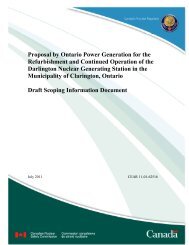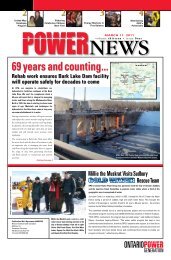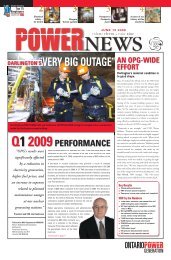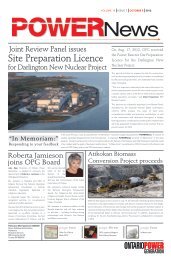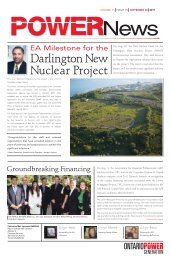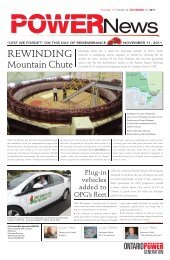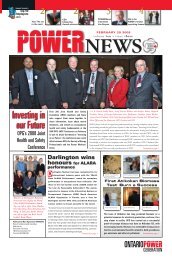Create successful ePaper yourself
Turn your PDF publications into a flip-book with our unique Google optimized e-Paper software.
I n s i d e f e a t u r e s<br />
The big<br />
deal about<br />
vitamin D<br />
Atikokan GS<br />
helps Walleye<br />
program<br />
2 3 3 4<br />
OPG’s Wayne<br />
Weller at<br />
DeCew’s tree<br />
planting event<br />
Sharing history<br />
and tradition<br />
MAY <strong>21</strong> 2010<br />
v o l u m e t w e l v e • i s s u e n i n e<br />
Project<br />
success<br />
is all<br />
about<br />
the<br />
planning<br />
W<br />
ith the help of hundreds of<br />
people, countless materials and<br />
around-the-clock dedication, the Pickering<br />
Safe Storage Project is almost complete.<br />
Although other types of nuclear reactors<br />
have been safely stored before, this has<br />
never been completed on CANDU units<br />
anywhere in the world.<br />
The two units have been placed into safe storage configuration<br />
until the eventual dismantling and decommissioning activities<br />
occur.<br />
The project began in 2005 and will wrap up this summer, on<br />
schedule and on budget. Pickering A Units 2 and 3 will be<br />
officially disconnected from the rest of the plant. A few systems<br />
will remain operational but the majority will be isolated. To<br />
separate from the rest of the plant, each system on Units 2 and 3<br />
must go through a process involving reports and procedures, as<br />
well as manual work. As of March 31, 81 systems went through<br />
this process, with the remaining <strong>21</strong> scheduled for the Vacuum<br />
Building Outage. Final paperwork will be completed this fall.<br />
The project represents an investment of $360 million and<br />
involved staff with specialized skills performing very complex<br />
work.<br />
Our success on major projects like this helps build trust and<br />
confidence in our company and demonstrates OPG’s ability<br />
to manage large projects. The lessons learned on Safe Storage<br />
will pave the way for future projects, including the Darlington<br />
Refurbishment.<br />
Employees participated<br />
Darlene Baker is the sister of Joseph<br />
in the Day of Mourning<br />
Baker, who died in November 1972 during<br />
at OPG sites across the<br />
the construction of the Lennox plant at<br />
province on April 28. In<br />
this photo from the commemorative ceremony<br />
at Lennox GS, employees pause<br />
for a moment of silence. Pictured here<br />
(from left to right) are: Darlene Baker;<br />
the young age of 19. Darlene spoke at the<br />
Lennox ceremony and shared how the<br />
accident impacted her family. She also<br />
attended a ceremony in 1999, to dedicate<br />
the Lennox Day of Mourning memorial.<br />
Publication Mail Agreement #40062445<br />
Return Undeliverable Canadian<br />
Address to:<br />
Pensioner Services<br />
700 University Ave H5<br />
Toronto ON M5G1X6<br />
Day of<br />
Mourning<br />
Darlene’s son, Joseph Lyons; Tony<br />
Kokus, OPG employee and representative<br />
for the Society of Energy Professionals;<br />
Al Brandon, OPG employee and<br />
representative for the <strong>Power</strong> Workers’<br />
Union; and Frank Chiarotto, Senior Vice<br />
President, Thermal.<br />
The Day of Mourning is an opportunity<br />
for employees to honour those who have<br />
died, suffered an injury or experienced<br />
illness at work. Ceremonies encourage<br />
employees to reflect on our losses and<br />
think about how we can build a safer<br />
future.
page 2<br />
IT’S ALL ABOUT PEOPLE<br />
volume twelve • issue nine<br />
HEALTH & WELLNESS<br />
Vitamin D<br />
Dr. Sotto says...<br />
“What’s the BIG deal<br />
about vitamin D?”<br />
The big deal is that vitamin D can protect you against<br />
significant diseases and illness such as cancer (colorectal,<br />
breast, ovarian, prostate), heart disease, stroke, diabetes,<br />
depression, osteoporosis, arthritis, multiple sclerosis,<br />
autoimmune diseases and more, according to extensive<br />
research studies.<br />
Statistics Canada says most Canadians are deficient in<br />
vitamin D. According to a recent study, about 37,000<br />
Canadians or 16% of the Canadian population can be<br />
saved from premature death if they increase their daily<br />
intake of vitamin D.<br />
So how do you know if you’re getting enough vitamin D to<br />
stay healthy? You can find out through a simple blood test<br />
which can be ordered by your doctor.<br />
Where can you get vitamin D? It is produced in your skin<br />
when you’re exposed to Ultraviolet B (UVB) rays from the<br />
sun during midday in the summer. It can also be found in<br />
fatty fish (salmon, tuna, mackerel, and sardines), milk, egg<br />
yolk, liver and orange juice fortified with vitamin D, and<br />
through liquid or tablet supplements.<br />
Vitamin D also helps your body absorb calcium, which is<br />
especially important after age 30 when bone mass starts to<br />
decrease. Adults should ingest at least 1,000 to 1,500 mg of<br />
calcium per day, depending on your age or as recommended<br />
by your doctor.<br />
The Canadian Cancer Society recommends that adults<br />
living in Canada increase their daily vitamin D intake to<br />
1,000 IU. This can be obtained by 10 minutes of daily,<br />
VITAMIN<br />
direct skin exposure to sunlight in the spring and summer,<br />
and by taking vitamin D supplements in the fall and<br />
winter. Visit your doctor for more information and to take<br />
a blood test to ensure you are getting enough vitamin D.<br />
ZERO INJURIES. BELIEVE IT. ACHIEVE IT.<br />
Improved WPC<br />
OPG Work Protection Code Gets<br />
a Facelift<br />
Recent revisions to the OPG Work Protection Code (WPC) have resulted in not only a<br />
higher level of protection for employees, but also in the achievement of a major regulatory<br />
milestone.<br />
Over the last two years, work has been underway to improve OPG’s WPC to<br />
align with new Ministry of Labour (MOL) requirements for “complex<br />
group lockout and tagout”. These requirements which were finalized<br />
in December 2008 after several years of consultation with the<br />
MOL mark a significant achievement in the MOL’s recognition<br />
of the safety afforded by OPG’s current processes.<br />
With the work coordinated by an OPG-wide project team of WPC experts led by<br />
Corporate Safety, WPC improvements required detailed action plans involving over 150<br />
employees from across OPG. One part of the governance for this transition was developed<br />
by the tripartite Corporate Code Advisory Group, who revised the WPC with over 50 new/<br />
modified rules. The end result will be noticed by all employees who rely on work protection<br />
to isolate the energies associated with their work.<br />
Some of the major changes include:<br />
• a new requirement to add additional protection (e.g., locks) to thousands of high-risk<br />
energy isolating devices;<br />
• a new process where workers verify through initials their understanding of the status of<br />
isolation; and<br />
• additional training for permit holders on the hazards<br />
associated with their work environment.<br />
Businesses are transitioning to these new requirements in<br />
2010 with Thermal, Hydro and Corporate Real Estate<br />
sites already complete. Due to longer lead times for work<br />
protection planning and the critical Pickering Vacuum<br />
Building Outage, Nuclear’s transition will be complete<br />
by August 1, 2010.<br />
Mary Lou Sinclair, Director of Corporate Safety, summed up this accomplishment best:<br />
“It took a great team effort from employees across OPG to make the WPC an even safer<br />
Code to live by. It is this kind of employee commitment and dedication to safety that will<br />
help us achieve our overall goal of Zero Injuries.”<br />
If you have any questions about this project, please contact Cathy Catton at<br />
(416) 592-4015.<br />
DIVERSITY<br />
OPG’s Equity Survey<br />
Are You In?<br />
Throughout the month of <strong>May</strong>, we are asking all<br />
employees to count themselves in by completing<br />
OPG’s Employment Equity Survey. This short, voluntary<br />
survey will help OPG to better understand<br />
its workforce and meet the needs of all employees.<br />
Under the Federal Employment Equity Act (FEEA),<br />
OPG has an obligation to monitor and report detailed<br />
data regarding designated groups – Aboriginal<br />
Peoples, Visible Minorities, Persons with Disabilities<br />
and Women – in its employee population. It<br />
is critical that this information be kept current,<br />
not only to meet the obligations of the FEEA, but<br />
because it may also result in changes in training,<br />
support and accommodation programs that affect<br />
all employees and benefit our company through diversity.<br />
The EE workforce survey is the only means<br />
by which this information can be gathered.<br />
Typically, this survey is completed by employees<br />
when they join the organization, but it can be<br />
completed or updated at any time throughout your<br />
career with OPG.<br />
If you did not complete the EE workforce survey<br />
when you joined OPG or if you need to update the<br />
information in the survey (e.g., if you have developed<br />
a disability), please consider doing so today.<br />
To complete the survey, login to ESS, mouse-over<br />
Personal Information and click on Employment<br />
Equity Survey, or obtain a paper copy from your<br />
HR Consultant.<br />
All information collected through the EE survey<br />
is confidential. It will only be used for statistical<br />
purposes with no names identified. If you have any<br />
questions, please contact your Human Resources<br />
Consultant.
OPG CELEBRATES EARTH DAY<br />
page 3<br />
volume twelve • issue nine<br />
With the help of Atikokan GS<br />
- the Walleye is Back!<br />
The Walleye did indeed do its part and anglers are once again<br />
happy as the Walleye fishery in Lower Marmion Lake has<br />
re-opened. This comes after an 11 year closure of the fishery<br />
and a program to improve the Walleye population that was<br />
carried out by the Ministry of Natural Resources (MNR) and<br />
OPG.<br />
To help move the program forward, Atikokan GS partnered<br />
with the Atikokan Sportsman’s Conservation Club and<br />
the MNR in a stocking program, which introduced 12 million<br />
regionally-sourced fry into Marmion Lake over a threeyear<br />
period commencing in 1998. A succession of netting<br />
surveys, funded by OPG, monitored the population and signs<br />
The Atikokan Progress article of Jan. 18, 1999 read,<br />
“Cooperation made the new Abie/Marmion Lake<br />
Spawning Bed a reality for the Community – the<br />
rest is up to the Walleye!” Flash forward 10 years to<br />
Jan. 5, 2009, and the Progress article reads “OPG,<br />
MNR Efforts Pay Off – Marmion walleye fishery<br />
recovered – angling closure lifted after 11 years.”<br />
In 1996, a fishery study indicated that the Walleye population<br />
in Lower Marmion Lake near Atikokan was in a serious decline.<br />
Lower Marmion Lake was created by impoundments<br />
and flooding of surface lands during the active mining years<br />
of the Steep Rock Lake iron ore mines. It is now one of several<br />
lakes that form a chain of “circuit cooling water lakes”<br />
for Atikokan GS. While the decline of Walleye in the lakes<br />
was not attributed to a single cause, there was evidence that<br />
the station’s fluctuating discharge flows and thermal effluents<br />
were causing early spawning and “hatch advance” of<br />
Walleye before their natural food supply had emerged. The<br />
issue became such a serious concern for local anglers and<br />
the MNR that the lakes were closed to Walleye fishing until<br />
further notice.<br />
“The issue proved a unique engineering and biological challenge<br />
in order to prevent migration of Walleye to their usual<br />
spawning area, while allowing water to continue to circulate<br />
through the lake system,” said Gerry McKenna, Senior Environmental<br />
Scientist, Thermal. “A creative solution was to<br />
design a weir that doesn’t hold water and prevents fish from<br />
going upstream, the opposite of what most weirs and dams<br />
are required to do.” The weir was installed at the outlet of<br />
Abie Lake to Marmion Lake in 1998 and consists of porous angled<br />
screens anchored between gabion blocks. In addition, a<br />
new spawning bed was developed immediately downstream<br />
of the weir.<br />
of recovery started to show with increasing recruitment of<br />
younger fish to the overall population. Over the years, Atikokan<br />
GS staff worked with the MNR to review the results as<br />
well as ensure the new weir was properly maintained and<br />
inspected.<br />
Brian Jackson, a biologist in MNR’s Atikokan area office, was<br />
involved throughout the program. “It’s definitely a success<br />
story,” he said, adding that public support for the closure was<br />
strong, and OPG’s support for the overall effort was crucial.<br />
OPG contributed over half a million dollars to build the weir<br />
and support the stocking and netting surveys. “While it took<br />
11 years, the re-opening of the Walleye fishery at Atikokan<br />
demonstrates that, if we do our part, nature will do the rest,”<br />
says Ed Enge, Production Manager, Atikokan GS. In 2010,<br />
the “year of biodiversity,” this is a case of putting words into<br />
action to protect biodiversity.<br />
Over 150 employee volunteers and their<br />
families, local Scouts, and community<br />
members participated in a soggy but successful<br />
tree-planting event at Nanticoke<br />
GS on <strong>May</strong> 1. Over 2,000 white pine and<br />
white spruce seedlings were planted<br />
to enhance biodiversity on the site.<br />
Since 1997, over 35,000 trees have been<br />
planted at Nanticoke. Nicole Goulet,<br />
Thermal Env. Chemical & Safety Technician/Technologist,<br />
with sons Joshua<br />
(left) and Gavin.<br />
Wayne Weller, OPG<br />
Senior Environmental<br />
Scientist, displays a<br />
cedar tree, one of the<br />
species of trees planted<br />
at Decew Headworks<br />
site during an<br />
Earth Day tree planting<br />
event. Niagara<br />
plant group volunteers<br />
planted about<br />
400 seedlings during<br />
the event.<br />
Lori Matorcevic and her daughter, Alexandra,<br />
joined 250 volunteers to help plant about 650 indigenous<br />
trees and shrubs at Alex Robertson Park in<br />
Pickering. Thanks to a successful partnership between<br />
OPG, Toronto Region Conservation Authority,<br />
City of Pickering, Environmental Stewardship<br />
Pickering, along with other community groups and<br />
volunteers, more than 7,000 plantings have been<br />
made in the park as part of a wildlife corridor.<br />
Jill Ward, Environmental Advisor at Lambton GS, reads an OPG Earth Day message<br />
during a recent recording at Blackburn Radio Inc. The message aired on all<br />
three local Blackburn radio stations across Sarnia-Lambton on Apr. 22.
page 4<br />
R O U N D U P<br />
v o l u m e t w e l v e • i s s u e n i n e<br />
Mr. Ross poses<br />
with an eagle<br />
feather. The<br />
use of an<br />
eagle feather<br />
during group<br />
discussions is<br />
an Algonquin<br />
tradition and<br />
indicates who<br />
has the floor<br />
to speak.<br />
Sharing History and Tradition<br />
For a few years OPG’s Ottawa/St. Lawrence Plant Group has been<br />
working with the Bonnechere Algonquin Community (BAC), based in<br />
Petawawa along the Ottawa River, on many culture enriching projects.<br />
Recently OPG supported a BAC Aboriginal Awareness Program.<br />
Delivered by Harold “Skip” Ross, an Algonquin Elder, youths learn<br />
about Algonquin history, customs and traditions. “I really enjoy talking<br />
to the youths about my culture and passing on my knowledge to<br />
them,” said Mr. Ross. “It is really encouraging to see them so interested<br />
in Algonquin history.“ Mr. Ross has been presenting his material<br />
throughout the Ottawa Valley, with OPG’s support, since the Fall of<br />
2009. “I look forward to each and every presentation and hope that<br />
my teachings remain with the youths for years to come,” he added.<br />
Tackle Share Program<br />
and Water Safety<br />
Hey buddy!<br />
<strong>Ontario</strong> Provincial Police and<br />
Canada’s best known fisherman,<br />
Red Green (aka Steve Smith),<br />
join OPG once again this summer<br />
to educate people about<br />
the dangers around dams and hydro stations.<br />
“Stay Clear Stay Safe” print ads will be accompanied<br />
by television and radio spots featuring Steve Smith’s<br />
voice as the talking fish warning fishermen that if caught<br />
trespassing around hydro stations and dams, they face<br />
charges and fines of up to $2,000.<br />
Hydroelectric facilities are often remotely controlled to<br />
generate electricity as needed. This causes frequent<br />
and rapid changes in the water flow and levels often<br />
creating strong undertows, turbulence<br />
and sudden, powerful surges of water<br />
moving downstream in what was once<br />
calm-looking surface water.<br />
Red Green and OPP<br />
Reunite with OPG<br />
on Water Safety<br />
And this year, OPG has joined forces<br />
with the <strong>Ontario</strong> Federation of<br />
Anglers and Hunters to be the lead<br />
sponsor of “Tackle Share,” a 12-<br />
year old program aimed at lending<br />
– for free – fishing rods, tackle and reels to children and<br />
aspiring anglers who do not have their own equipment.<br />
With more than 200 sites across <strong>Ontario</strong>, OPG is sure to<br />
get its water safety message out to early users of our<br />
waterways.<br />
OPG also offers a variety of education materials on water<br />
safety, including a brochure, DVD for adults and an educational<br />
interactive computer game for children. You can<br />
go to opg.com to download materials.<br />
The water safety print ads, TV commercials<br />
and 30-second radio spots<br />
began <strong>May</strong> 17 across the province and<br />
run until September.<br />
I n M e m o r i a m<br />
FAVARO, PRIMO, 63, on Apr. 19, 2010, retired July 1, 2000; Technologist<br />
- Instrumentation Department, Kipling Complex<br />
GOOD, FRANKLIN, 89, on Apr. 18, 2010, retired <strong>May</strong> 1, 1980; District<br />
Electrical Foreman, Martindale TS<br />
KING, ALBERT E., 86, on Apr. 3, 2010, retired Feb. 1, 1982; Inspector -<br />
Mechanical and Structural, Kipling Complex<br />
KOSLOWSKI, JOHN, 68, on Apr. 11, 2010, retired Jan. 1, 2004; Shift<br />
Control Technician, Pickering Nuclear<br />
KRULL, PETER, 98, on Apr. 8, 2010, retired Dec. 1, 1971; Operating Superintendant,<br />
Reg. Office<br />
KUIPERS, TINA, 65, on Apr. 13, 2010, retired Nov. 1, 2002; Vault Officer,<br />
Head Office<br />
LOUCKS, WILLIAM, 88, on Mar. 20, 2010, retired Oct. 1, 1982; Manager<br />
- Computer Processing, 60 Murray Street<br />
MCRAE, TERRANCE, 56, on Apr. 13, 2010, retired Jan. 29, 2010; Rigger<br />
Journeyperson, Niagara TS<br />
MEWES, HINRICH W., 72, on Apr. 16, 2010, retired Nov. 1, 1993;<br />
Trades Management Supervisor, Kipling Complex<br />
PORTER, EVERETT C., 82, on Apr. 18, 2010, retired Feb. 1, 1988; <strong>Power</strong><br />
Maintenance Electrician A Journeyperson, Sir Adam Beck GS #1<br />
RIDDELL, FAYE, 66, on Apr. 16. 2010, retired July 1, 2004; Disbursements<br />
Clerk, Lambton GS<br />
TOYAMA, JOSEPH S., 83, on Apr. 16, 2010, retired Apr. 1, 1992; Field<br />
Tech V - Electrical and Co., Pickering Nuclear<br />
TUCKER, REG A., 78, on Apr. 7, 2010, retired Oct. 1, 1993; Security<br />
Guard, Bruce Nuclear<br />
E N E R G Y C U R R E N T S A roundup of industry news and events<br />
Industrialized nations’ CO2 falls 2.2<br />
per cent in 2008 Industrialized nations’ greenhouse<br />
gas emissions fell by 2.2 per cent in 2008, the steepest decline<br />
since the break-up of the Soviet Union as economies slowed,<br />
according to a Reuters compilation.<br />
Emissions are likely to have fallen more sharply in 2009 due to<br />
the recession.<br />
• volume twelve<br />
• issue nine<br />
POWERNews is published by Public Affairs for<br />
the employees and pensioners of <strong>Ontario</strong> <strong>Power</strong><br />
<strong>Generation</strong>.<br />
Mailing Address: <strong>Ontario</strong> <strong>Power</strong> <strong>Generation</strong><br />
700 University Avenue, H19<br />
Toronto, ON M5G 1X6<br />
Fax: 416-592-<strong>21</strong>81<br />
E-mail: powernews@opg.com<br />
Got a story idea?<br />
We want to hear from you.<br />
Editorial Board<br />
Kathryn Peck, Managing Editor (416) 592-3243<br />
Ted DeWelles, Executive Editor (416) 592-6070<br />
Matt MacTavish, HR (416) 592-4127<br />
Gillian Salter, Energy Markets (416) 592-7012<br />
Jill Benneyworth, Thermal (416) 592-3499<br />
Rita Pasquarelli, Nuclear (416) 592-3690<br />
Richard Schwass, Hydroelectric (416) 592-2679<br />
Lisa Shields, Design Manager (416) 592-3151<br />
Daisy Wu, Finance (416) 592-3531<br />
Kathi Austerberry, Public Affairs (416) 592-2685<br />
Kim McLennan, Public Affairs (416) 592-6936<br />
Rob Lyng, Sustainable Development (416) 592-3193<br />
Final government data sent to the United Nations – used to<br />
judge compliance with climate treaties – shows that emissions<br />
from 36 nations fell to 17.10 billion tonnes of carbon dioxide<br />
equivalents in 2008 from 17.48 billion in 2007.<br />
U.S. greenhouse emissions fell by 2.8 per cent to the lowest<br />
level since 2001 and European Union emissions were down<br />
2.0 per cent. A main exception was Russia, with a 1.9 per cent<br />
rise in 2008.<br />
The overall 2008 fall drove industrialized nations’ emissions to<br />
6.7 per cent below levels in 1990, the U.N. benchmark year for<br />
judging efforts to avert heatwaves, floods, droughts, species<br />
extinctions and rising sea levels.<br />
-Reuters, April 22<br />
OPG Pensioner Services<br />
Mailing Address: Pensioner Services<br />
700 University Avenue, H5<br />
Toronto, ON M5G 1X6<br />
Telephone: 416-592-7300 or 1-877-550-3888<br />
Fax: 416-592-1540<br />
E-mail: pensionerservices@opg.com<br />
Website: https://pensioners.opg.com<br />
OPG Website: www.opg.com<br />
Also available on internal & pensioner websites.<br />
Design, Print and Publication<br />
OPG Office Services<br />
Printed on 100%<br />
recycled paper



